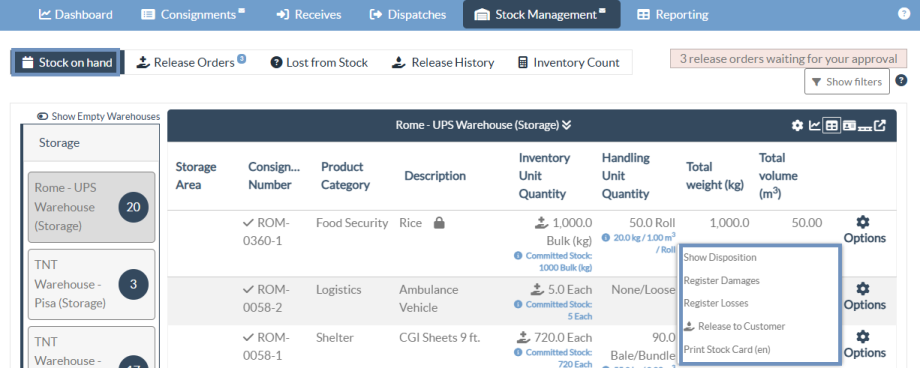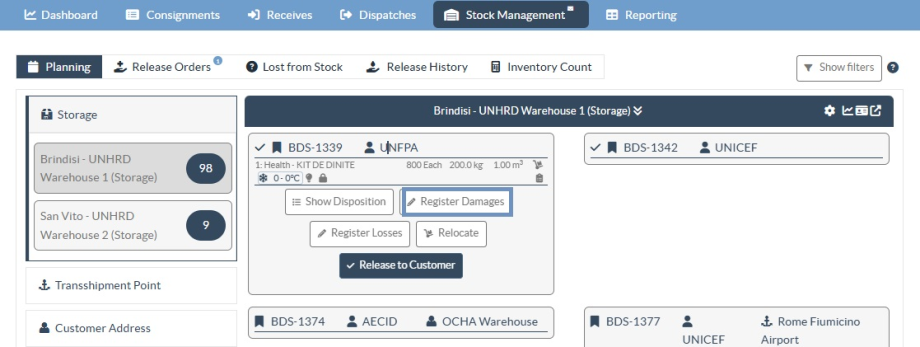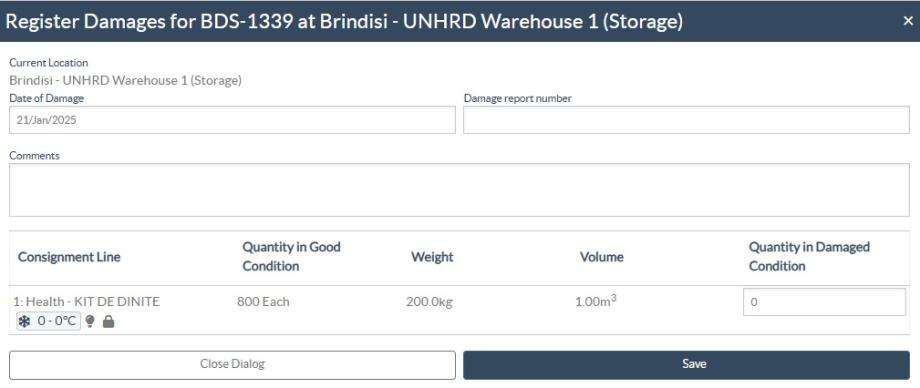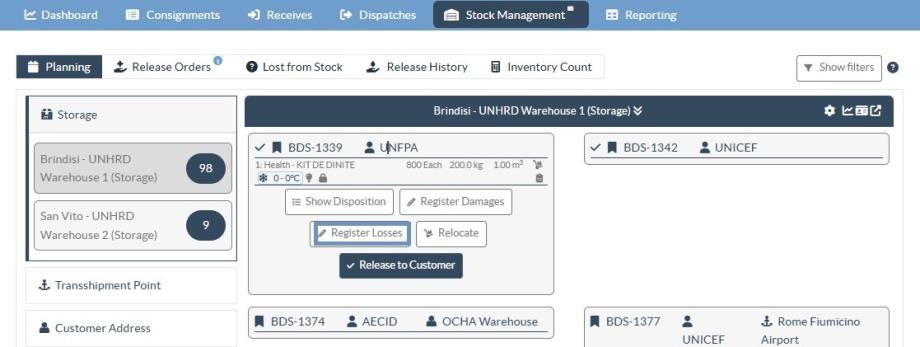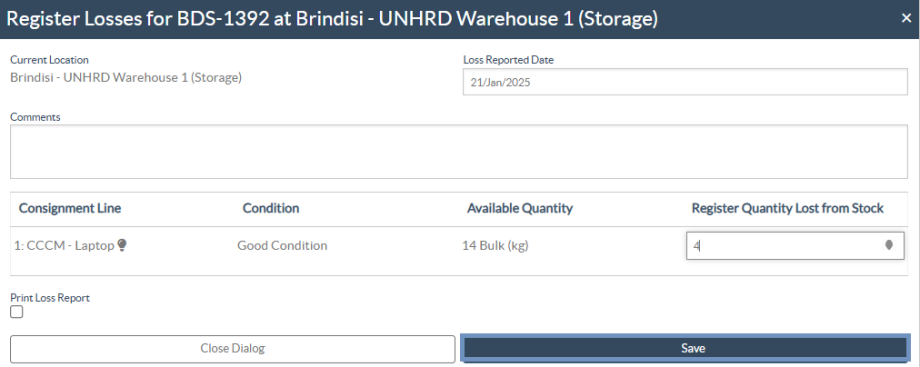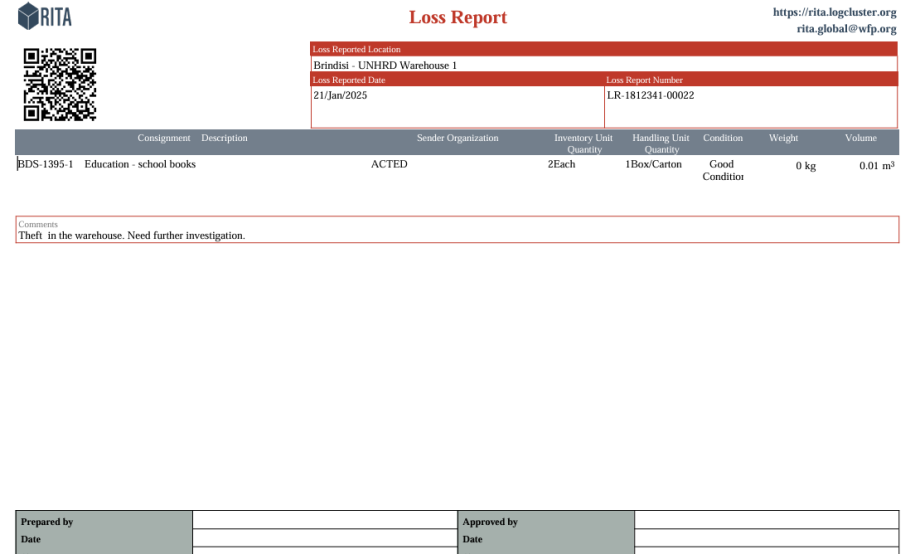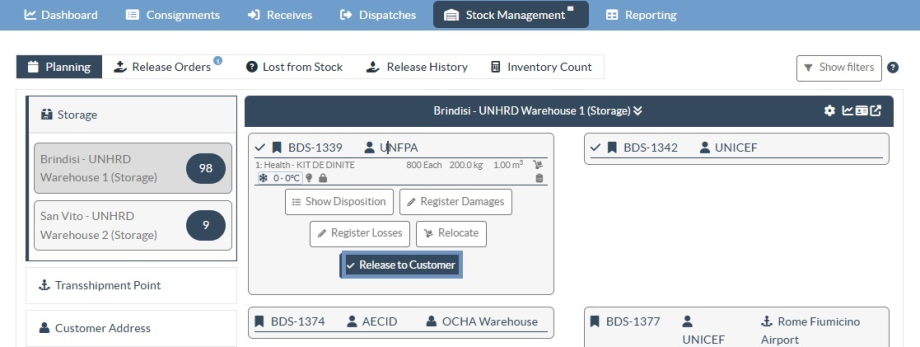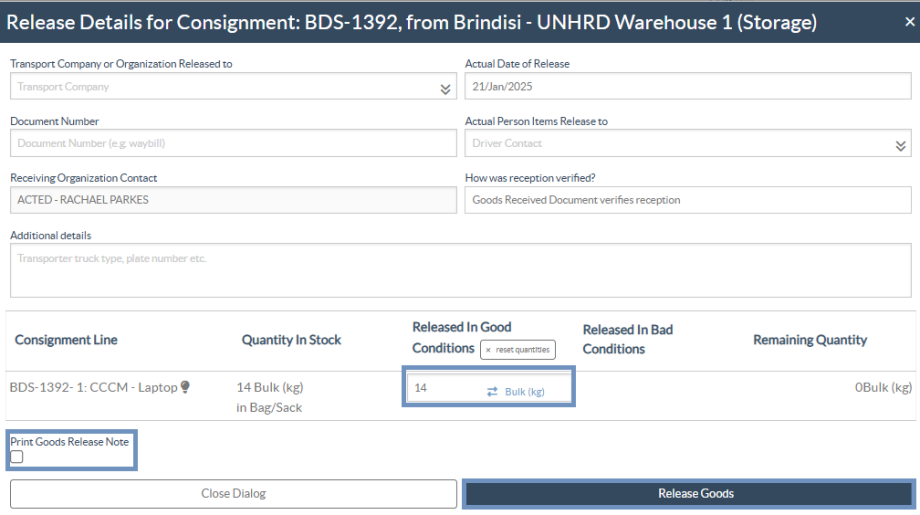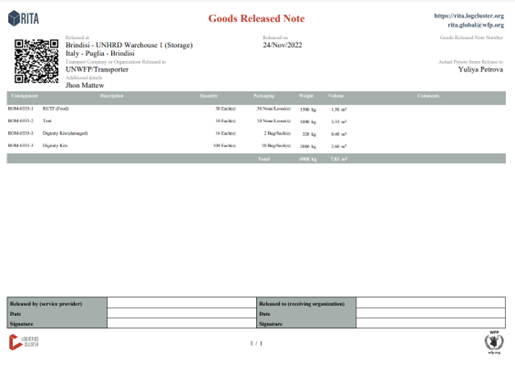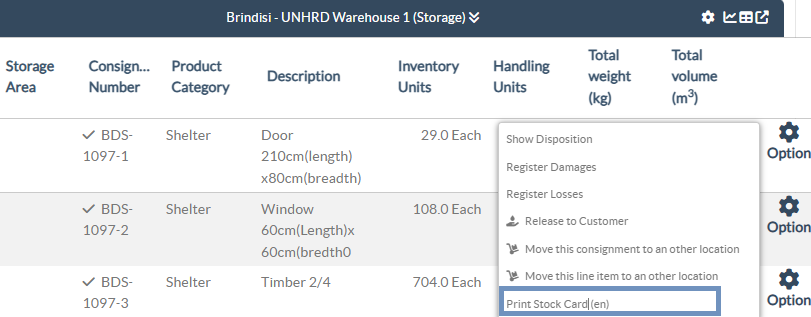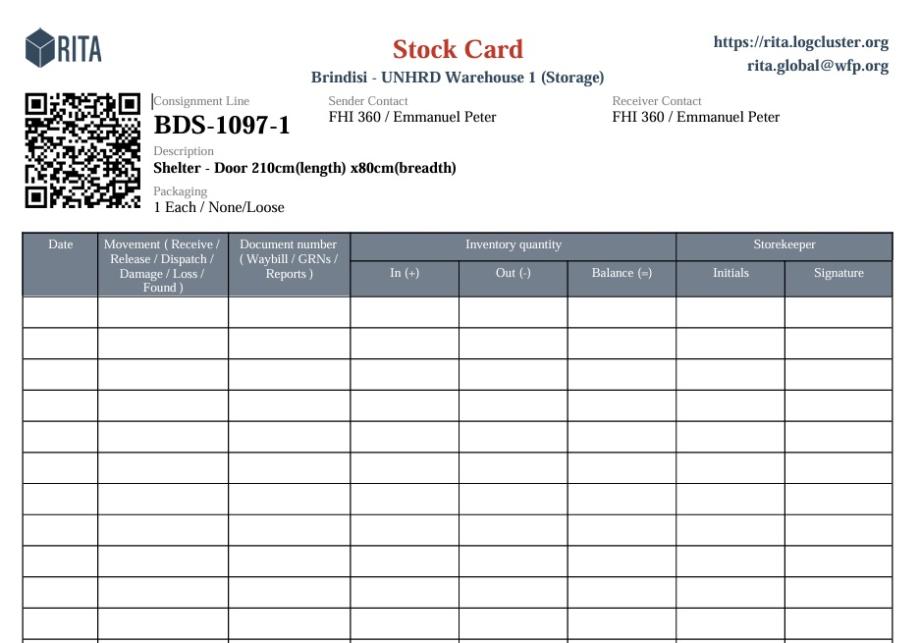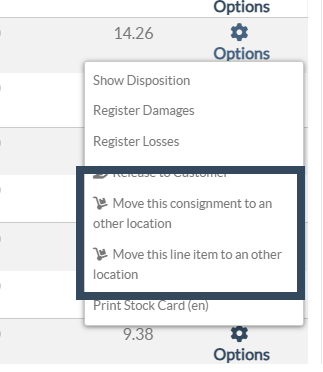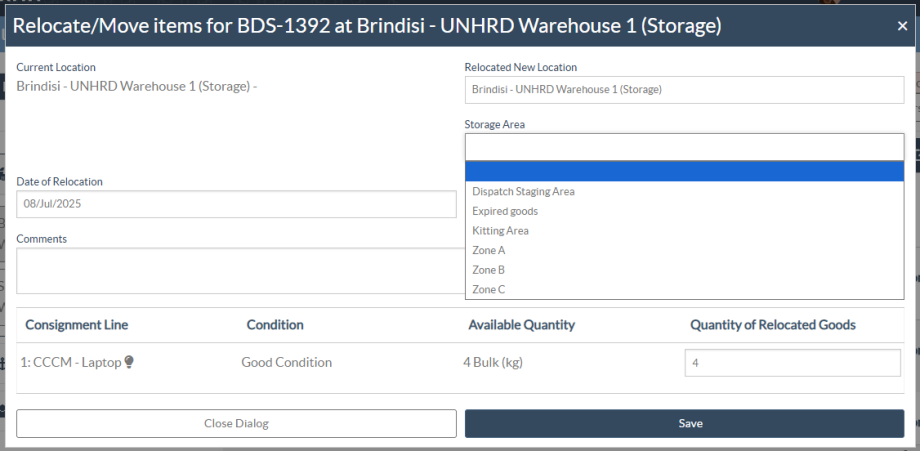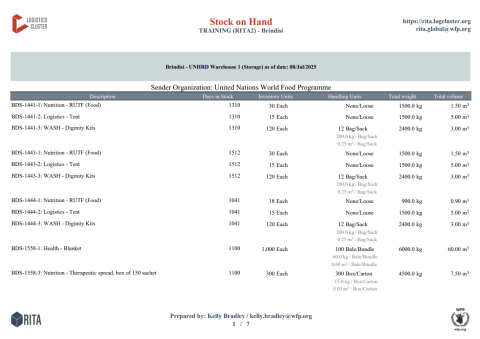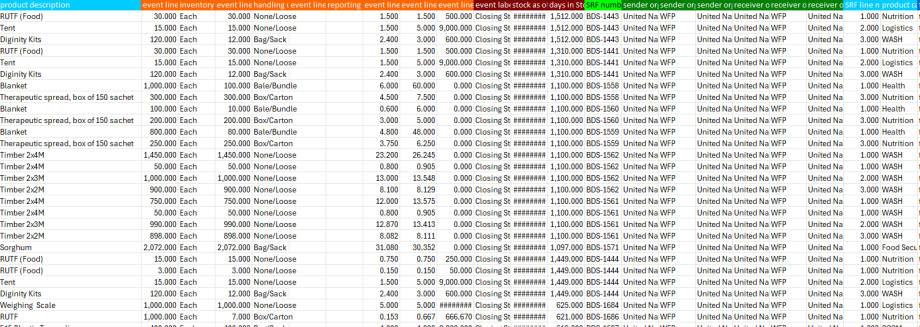The "Stock on Hand" tab allows RITA operators to manage their stock. They can view the consignment details via the stock disposition screen, register losses and/or damages in storage, release goods to the final customer, and print a stock card.
The initial screen lists all the items received in storage, at a transshipment point, or the customer's address, along with their basic details and shipping information.
The page provides the operators with three additional options for viewing the file:
- They can switch the presentation mode from item level to consignment view (card-based)
- They can see the graphs showing the utilization of storage.
- Also, export the consignment details to XLS or a PDF file.
Stock Disposition
Please refer to the chapter "Consignment Identification".
Register Damages
When items are stored in a designated warehouse (storage/transshipment point/customer address), the operators can record any damages or losses reported during the inspection. To register the damage to the items in storage, click on the option “Register Damages” within the box.
The operator should provide the number of damaged items, the damage report number, and comments. Please note that RITA only accepts damaged quantities in Inventory Units.
Register Losses
When items are stored in a designated warehouse (storage/transshipment point/customer address), the operators can record any losses noted during an inspection. To register the loss of items in storage, click on the option “Register Losses” within the box.
The operator must provide the quantity of lost items, the loss report number, and any comments. Please note that RITA only accepts lost quantities in inventory units.
Print Loss Report
Within the “Loss Register” box, users can select “Print Loss Report,” which enables the RITA operator to generate automatic forms for the lost items in the consignment.
The loss Report includes the following details:
| Consignment Description: | Description of the missing items, including product category, quantities, units of measurement, their condition, volume, and weight. |
| Loss Reported Location: | The exact location where the loss occurred. |
| Loss Reported Date: | It reflects the date on which loss is registered in RITA |
| Loss Report Number: | The report number is automatically generated by RITA. |
| Comments: | The RITA operator must provide a detailed account of how the loss occurred, including possible reasons such as mishandling, theft, and errors. They should give the approximate financial value of the lost or damaged goods and recommend steps to prevent similar losses if available. |
| Signatures: | Relevant personnel, such as warehouse managers and storekeepers, must sign the loss report to verify it. |
 | All the consignments with registered losses are listed under the “Lost from Stock” section of the “Dispatches” screen. To reverse the losses, the operator must go to the section “Cancel Losses” and follow the steps of reversal |
Release to Customer
The “Release to Customer” button is selected to transfer the goods to the customer. The "Stock on Hand" screen records all the cargo received in storage, at a transshipment point, or at the customer address that has not been released to the customer.
Even though items have been dispatched and receipt confirmed at the destination, the consignment still needs to be released to the customer so it can no longer be considered in the inventory. Therefore, for all the releases, the operator must open the “Stock on Hand” tab of the “Stock Management” screen.
Clicking on the option “Release to Customer,” the following window will appear:
| Transport Company or Organization released to: | Insert either the name of the organization receiving the items or the name of the transport company picking up the items on behalf of the receiver. |
| Actual Date of Release: | Provide the actual date of release of the items. |
| Document Number: | If there is a document confirming the receipt, insert the document number- for example, Waybill # or GRN # |
| Actual Person Items Release to: | Insert the name of the organization’s representative receiving the items or the name of the driver of the transport company. |
| Receiving Organization contact: | Provide the contact details of the organization that received the consignment. |
| How was the reception verified: | This explains how the RITA operator confirmed that the customer has received their items, either verbally by Phone, in writing by email, or through a Goods Received Document (this can be a signed Waybill). |
| Additional details: | Any additional information, such as transport type, truck plate number, etc., that the operator may want to type for the release. |
After completing the fields, click “Release Goods” to confirm the final release of the cargo to the customer.
 | When goods are finally released to the customer, the consignments are listed under the “Release History.” Therefore, the operator must find the consignment under “Release History” to cancel the releases and follow the reversal steps. |
Print Goods Release Note
Rita allows users to automatically print the "Goods Release Note" from the system. This note acts as an official record confirming the release of a shipment to the final customer. It includes all relevant details of the shipment provided by the RITA operator at the time of release outlined below:
- Description of items being released, including quantity, units, weight, volume, and value
- Exact date when the items were handed over to the final customer.
- Details of the person or organization receiving the goods
- Signature of responsible parties, including both service provider and receiving organization.
- Document Number (if any) manually entered by the service provider at the time of release.
- When the RITA operator checks the box to print the released goods, the system automatically generates a goods release note number, which is then printed.
 | RITA Operators can also generate automatic Goods Release Notes from the “Release History” tab in the Stock Management screen. Please refer to “Release History.” |
Print Stock Card
Click on “Options” and select “Print Stock Card" from the dropdown menu
- The “Print Stock Card” option automatically enables the RITA operators to produce Stock Cards from RITA. A stock card is a physical record used to track the movements of specific items in and out of the warehouse.
- Stock cards are specific to each line item, and the QR code enables access to full consignment details.
The following are the details listed on the stock card form:
- Consignment number and line-item number.
- Sending and receiving organization details.
- Item description such as its name, product category, unit quantity and packaging, batch number, temperature range, and dangerous goods identification (if any).
- The dates on which the inventory transactions (such as receiving, dispatching, releasing, damage loss, found) occur.
- Any document number such as waybill, goods received/released note, or damage/loss report.
- Quantity of stock added or removed from the inventory and balance quantity after each transaction
- Initials/Signature of the storekeeper or any authorized personnel.
Moving Consignments or Line Items
The options “Move this consignment to another location” and “Move this line item to another location” will only appear in the Options menu if a Storage Area has been defined within the consignment.
A Storage Area refers to a designated sub-location within the main Storage Location (e.g., a specific zone or shelf within a warehouse) where goods are stored. Defining this field allows the system to track and manage inventory at a more granular level.
These two movement options serve the following purposes:
- Move this consignment to another location: Transfers the entire consignment from one storage area to another within the same warehouse or across different storage areas.
- Move this line item to another location: Allows users to relocate a specific item (line item) within the consignment, without moving the full consignment.
These features are useful for inventory reorganization, optimizing space, or handling segregation requirements such as damaged, temperature-sensitive goods or expired goods.
Stock on Hand Report
RITA provides the functionality to export stock on hand reports by organization into either Excel or PDF format. To do so, follow the steps below:
Step 1: Click the “Export” option located on the right side of the screen.
Step 2: A Storage Overview dialog box will appear. RITA operators may select specific dates and the organization for which to generate reports.
- By default, the date will indicate the current date, but RITA operators may select any previous date to generate a stock report from any point in the past.
- If the "Organization" dropdown list is left blank, the report will return results for all organizations.
Step 3: Click “Export” to proceed. RITA will prompt you to choose the file format, either .xls or .pdf.
Step 4: Selecting PDF will generate a report showing the stock on hand for the selected organization on the specified date.
Example: The PDF below will display a summary of closing stock quantities for WFP at Brindisi Warehouse (Storage) as of date: 08/Jul/2025
Step 5: Selecting XLS will download a simplified Excel spreadsheet providing a storage overview.
Example: This file includes only the closing stock on hand of WFP at Brindisi Warehouse (Storage) as of date: 08/Jul/2025

